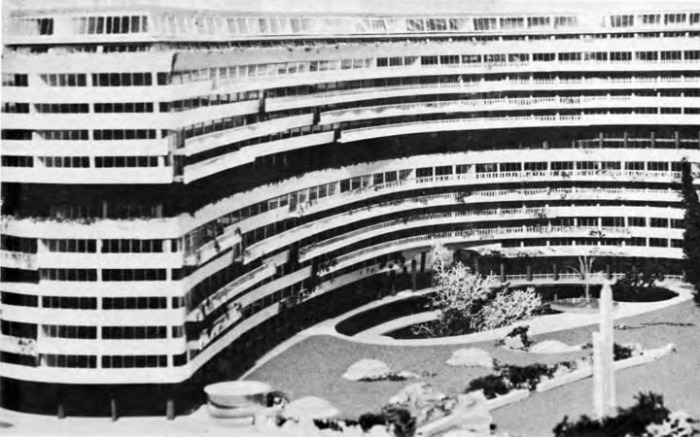In his editorial for May 1964, Mississippi Architect editor and Jackson architect Edward F. Neal notes the language barrier between architects and clients. This is and probably always will be a problem with any kind of specialized field, and like doctors, some architects are better than others at translating their language into ours.
Since this is such a short piece, I’ll throw in another brief article from the same issue of Mississippi Architect free of charge. It seems there was a big new apartment complex in Washington DC just opening. We know it more for its sordid political associations than for its architecture. Can you guess its name (without peaking)?
———————————————————————
The Language Barrier
It’s not surprising if you have experienced difficulty in communicating with your architect over the conference table.
We sat in on a conference recently and listened to a very learned architect explain his design for a proposed building to an equally astute group of clients. In the course of his explanation he used the term “spatial tension” and one of the group asked for an interpretation. It was a trying situation because the architect could not make himself understood without going into a series of graphic illustrations which would have had the adverse effect of sidetracking everyone’s train of thought. As a result the term probably remained unclarified in the clients’ minds.
The incident in itself would be relatively insignificant except that (1) it represents a common occurrence between architects and their clients; (2) the term was properly used; and (3) if we can’t understand each other then the product of our common effort will suffer.
It would be rewarding if, outside of the conference room, when possible, you ask your architect to clarify some of the terms he uses. He will certainly make the effort and if the results are mutually acceptable then each of you will have taken a step toward breaking the barrier.
– Edward Neal
————————————————————————————————-
Washington Complex Has “Living Shape”

LUIGI MORETTI, internationally reputed architect, refers to his design of the new $66 million Watergate apartment, hotel and office complex, to be constructed in Foggy Bottom, in Washington, D. C., as one with a “living shape.”
Moretti, who believes “modern architecture has an international language,” compared the richly landscaped site to comparable landscaping in Italy.
“All beautiful places have the same feeling,” he said, “and here we allowed the natural landscape and monumental character of Washington to determine the basic placement and design of the buildings.” ‘
“The free form design,” Moretti stated, “complements the triangular 10-acre setting, blends naturally with the shoreline of the Potomac and highlights Washington’s particular beauty.”
The Watergate Project, known as the Garden City Within A City, is Moretti’s first major design to be built in the United States. He has, however, designed similar complexes in Italy and other countries.
The Watergate complex will consist of 3 apartment buildings, a residential hotel, an office building, community shopping facilities, including restaurants and a limited number of villas situated throughout the landscaped area.
The residential hotel will be located at the center of the complex and connected in a rough V-form to an office building with 200,000 sq. ft. fronting on Virginia Avenue. There will be three levels of underground parking providing a 1,250 car capacity.
The Watergate design stays away from cubic and rectangular shapes, Moretti pointed out, replacing them with free flowing curves which give the feeling of dynamic life.
The circular design of Watergate creates between the buildings a large garden area which provides a continuation of the natural green park along the Potomac.
Roofs of the buildings will be completely landscaped and residents of the top floor will be able to enjoy individually designed terraces.
———————————————
This article is reprinted from the May 1964 issue of the Mississippi Architect, with permission from the Mississippi Chapter of the American Institute of Architects. View the full May 1964 issue of Mississippi Architect in a digitized format, or for other articles in this ongoing series, including the pdf version of each full issue, click on the MSArcht tab at the top of this page.
Categories: Architectural Research

I think you have given me the perfect description of what happens in my brain over these uncontrolled random preservation battles popping up all over Natchez: the ongoing preservation project at Melrose, oil drilling at Arlington, toilet treasures pulled from Dunleith, tacky new casino development on our Landmark bluff (but better than it was – thank you Mimi Miller), and now a prospective new low income housing development across from Forks of the Road slave market site – it’s just “spacial tension!”
LikeLike
Wow, I just realized at the end of the day that the post that went up this morning was not the post I thought I had saved last night! Somehow it just saved the basic core that I started with. I wondered why I didn’t get more comments! Anyway, thanks for not mentioning it, Kathleen :-)
And yes, “spatial tension” can politely describe a number of heated situations, can’t it?
LikeLike